Process Control via Electrical Impedance Tomography for Energy-Aware Industrial Systems
Abstract
1. Introduction
1.1. Background and Related Work
1.2. Motivation, Novelty and Paper Structure
2. Materials and Methods
2.1. Description of the Alcoholic Fermentation Process
2.2. Experimental Setup
2.3. Simulation Environment
3. Results
3.1. Simulation Results for the Fermentation Model
3.2. Validation of the Alcohol Fermentation Monitoring Model
3.3. Energy Accounting for EIT-Supervised Fermentation: Models and Results
3.4. Sensitivity and Uncertainty Analysis of the Conductivity—Substrate Calibration Model
4. Discussion
5. Conclusions
Author Contributions
Funding
Data Availability Statement
Conflicts of Interest
Abbreviations
| AI | Artificial Intelligence |
| a.u. | arbitrary units |
| ATP | adenosine 5′-triphosphate |
| CMOS | Complementary Metal Oxide Semiconductor |
| ECT | Electrical Capacitance Tomography |
| EIT | Electrical Impedance Tomography |
| FEM | Finite Element Method |
| GPU | Graphics Processing Unit |
| LCD | Liquid Crystal Display |
| MLOps | Machine Learning Operations |
| MRI | Magnetic Resonance Imaging |
| NIR | Near Infrared Spectroscopy |
| NMR | Nuclear Magnetic Resonance |
| OCT | Optical Coherence Tomography |
| PAT | Process Analytical Technology |
| RJ-45 | Registered Jack 45 |
| RMSE | Root Mean Square Error |
| UST | Ultrasound Tomography |
| UV-Vis | Ultraviolet Visible Spectroscopy |
References
- Su, Q.; Ganesh, S.; Moreno, M.; Bommireddy, Y.; Gonzalez, M.; Reklaitis, G.V.; Nagy, Z.K. A Perspective on Quality-by-Control (QbC) in Pharmaceutical Continuous Manufacturing. Comput. Chem. Eng. 2019, 125, 216–231. [Google Scholar] [CrossRef]
- Gerzon, G.; Sheng, Y.; Kirkitadze, M. Process Analytical Technologies—Advances in Bioprocess Integration and Future Perspectives. J. Pharm. Biomed. Anal. 2022, 207, 114379. [Google Scholar] [CrossRef] [PubMed]
- Bowler, A.L.; Bakalis, S.; Watson, N.J. A Review of In-Line and on-Line Measurement Techniques to Monitor Industrial Mixing Processes. Chem. Eng. Res. Des. 2020, 153, 463–495. [Google Scholar] [CrossRef]
- Hong, C.Y.; Zhang, Y.F.; Zhang, M.X.; Leung, L.M.G.; Liu, L.Q. Application of FBG Sensors for Geotechnical Health Monitoring, a Review of Sensor Design, Implementation Methods and Packaging Techniques. Sens. Actuators A Phys. 2016, 244, 184–197. [Google Scholar] [CrossRef]
- Roberts, J.; Power, A.; Chapman, J.; Chandra, S.; Cozzolino, D. The Use of UV-Vis Spectroscopy in Bioprocess and Fermentation Monitoring. Fermentation 2018, 4, 18. [Google Scholar] [CrossRef]
- Kulisz, M.; Kłosowski, G.; Rymarczyk, T.; Hoła, A.; Niderla, K.; Sikora, J. The Use of the Multi-Sequential LSTM in Electrical Tomography for Masonry Wall Moisture Detection. Measurement 2024, 234, 114860. [Google Scholar] [CrossRef]
- Kłosowski, G.; Rymarczyk, T.; Niderla, K.; Kulisz, M.; Skowron, Ł.; Soleimani, M. Using an LSTM Network to Monitor Industrial Reactors Using Electrical Capacitance and Impedance Tomography—A Hybrid Approach. Eksploat. I Niezawodn. Maint. Reliab. 2023, 25, 2023. [Google Scholar] [CrossRef]
- Przysucha, B.; Wójcik, D.; Rymarczyk, T.; Król, K.; Kozłowski, E.; Gąsior, M. Analysis of Reconstruction Energy Efficiency in EIT and ECT 3D Tomography Based on Elastic Net. Energies 2023, 16, 1490. [Google Scholar] [CrossRef]
- Koulountzios, P.; Rymarczyk, T.; Soleimani, M. Ultrasonic Time-of-Flight Computed Tomography for Investigation of Batch Crystallisation Processes. Sensors 2021, 21, 639. [Google Scholar] [CrossRef] [PubMed]
- Ultrasound Tomography for Control of Batch Crystallization—The University of Bath’s Research Portal. Available online: https://researchportal.bath.ac.uk/en/studentTheses/ultrasound-tomography-for-control-of-batch-crystallization (accessed on 25 August 2025).
- Ziolkowski, M.; Gratkowski, S.; Zywica, A.R. Analytical and Numerical Models of the Magnetoacoustic Tomography with Magnetic Induction. COMPEL—Int. J. Comput. Math. Electr. Electron. Eng. 2018, 37, 538–548. [Google Scholar] [CrossRef]
- Gocławski, J.; Sekulska-Nalewajko, J.; Korzeniewska, E. Prediction of Textile Pilling Resistance Using Optical Coherence Tomography. Sci. Rep. 2022, 12, 1–15. [Google Scholar] [CrossRef]
- Korzeniewska, E.; Gałązka-Czarnecka, I.; Sekulska-Nalewajko, J.; Gocławski, J.; Dróźdż, T.; Kiełbasa, P. Assessment of Changes in Vitamin Content and Morphological Characteristics in Strawberries Modified with a Pulsed Electric Field Using Chromatography and Optical Coherence Tomography. NFS J. 2025, 38, 100217. [Google Scholar] [CrossRef]
- Hlava, J.; Abouelazayem, S. Control Systems with Tomographic Sensors—A Review. Sensors 2022, 22, 2847. [Google Scholar] [CrossRef] [PubMed]
- Hampel, U.; Babout, L.; Banasiak, R.; Schleicher, E.; Soleimani, M.; Wondrak, T.; Vauhkonen, M.; Lähivaara, T.; Tan, C.; Hoyle, B.; et al. A Review on Fast Tomographic Imaging Techniques and Their Potential Application in Industrial Process Control. Sensors 2022, 22, 2309. [Google Scholar] [CrossRef]
- Hollenberg, M.; Liebing, T.; Kern, T.A.; Kähler, D. Simulation Framework for Electrical Impedance Tomography Systems. Meas. Sens. 2025, 38, 101416. [Google Scholar] [CrossRef]
- Rao, G.; Aghajanian, S.; Koiranen, T.; Wajman, R.; Jackowska-Strumiłło, L. Process Monitoring of Antisolvent Based Crystallization in Low Conductivity Solutions Using Electrical Impedance Spectroscopy and 2-D Electrical Resistance Tomography. Appl. Sci. 2020, 10, 3903. [Google Scholar] [CrossRef]
- Yan, R.; Viumdal, H.; Mylvaganam, S. Process Tomography for Model Free Adaptive Control (MFAC) via Flow Regime Identification in Multiphase Flows. IFAC-Pap. 2020, 53, 11753–11760. [Google Scholar] [CrossRef]
- Yang, C.; Cui, Z.; Xue, Q.; Wang, H.; Zhang, D.; Geng, Y. Application of a High Speed ECT System to Online Monitoring of Pneumatic Conveying Process. Measurement 2014, 48, 29–42. [Google Scholar] [CrossRef]
- Metcalfe, B.; Acosta-Pavas, J.C.; Robles-Rodriguez, C.E.; Georgakilas, G.K.; Dalamagas, T.; Aceves-Lara, C.A.; Daboussi, F.; Koehorst, J.J.; Corrales, D.C. Towards a Machine Learning Operations (MLOps) Soft Sensor for Real-Time Predictions in Industrial-Scale Fed-Batch Fermentation. Comput. Chem. Eng. 2025, 194, 108991. [Google Scholar] [CrossRef]
- Wu, D.; Xu, Y.; Xu, F.; Shao, M.; Huang, M. Machine Learning Algorithms for In-Line Monitoring during Yeast Fermentations Based on Raman Spectroscopy. Vib. Spectrosc. 2024, 132, 103672. [Google Scholar] [CrossRef]
- Feng, Y.; Tian, X.; Chen, Y.; Wang, Z.; Xia, J.; Qian, J.; Zhuang, Y.; Chu, J. Real-Time and on-Line Monitoring of Ethanol Fermentation Process by Viable Cell Sensor and Electronic Nose. Bioresour. Bioprocess. 2021, 8, 1–10. [Google Scholar] [CrossRef] [PubMed]
- Kwon, H.; Shiu, J.; Rivera, E.C.; Yamakaya, C. Soft Sensor for Ethanol Fermentation Monitoring through Data-Driven Modeling and Synthetic Data Generation. In Proceedings of the 4th International Electronic Conference on Biosensors, Online, 20–22 May 2024; Volume 104, p. 30. [Google Scholar] [CrossRef]
- Zhang, T.; Tian, X.; Liu, X.C.; Ye, J.A.; Fu, F.; Shi, X.T.; Liu, R.G.; Xu, C.H. Advances of Deep Learning in Electrical Impedance Tomography Image Reconstruction. Front. Bioeng. Biotechnol. 2022, 10, 1019531. [Google Scholar] [CrossRef]
- Tinôco, D.; Batista Da Silveira, W. Kinetic Model of Ethanol Inhibition for Kluyveromyces marxianus CCT 7735 (UFV-3) Based on the Modified Monod Model by Ghose & Tyagi. Biologia 2021, 76, 3511–3519. [Google Scholar] [CrossRef]
- Rzasa, M.; Łukasiewicz, E.; Wójtowicz, D. Test of a New Low-Speed Compressed Air Engine for Energy Recovery. Energies 2021, 14, 1179. [Google Scholar] [CrossRef]
- Urry, L.A.; Cain, M.L.; Wasserman, S.A.; Minorsky, P.V.; Orr, R. Biologia Campbella, 12th ed.; REBIS: Poznań, Poland, 2025. [Google Scholar]
- Yadav, M.; Yadav, H.S. Biochemistry: Fundamentals and Bioenergetics; Bentham Science Publisher: Sharjah, United Arab Emirates, 2021; Volume 418. [Google Scholar]
- Ji, X.X.; Zhang, Q.; Yang, B.X.; Song, Q.R.; Sun, Z.Y.; Xie, C.Y.; Tang, Y.Q. Response Mechanism of Ethanol-Tolerant Saccharomyces cerevisiae Strain ES-42 to Increased Ethanol during Continuous Ethanol Fermentation. Microb. Cell Fact. 2025, 24, 1–15. [Google Scholar] [CrossRef]
- Wolf, I.R.; Marques, L.F.; de Almeida, L.F.; Lázari, L.C.; de Moraes, L.N.; Cardoso, L.H.; Alves, C.C.d.O.; Nakajima, R.T.; Schnepper, A.P.; Golim, M.d.A.; et al. Integrative Analysis of the Ethanol Tolerance of Saccharomyces cerevisiae. Int. J. Mol. Sci. 2023, 24, 5646. [Google Scholar] [CrossRef]
- Christofi, S.; Papanikolaou, S.; Dimopoulou, M.; Terpou, A.; Cioroiu, I.B.; Cotea, V.; Kallithraka, S. Effect of Yeast Assimilable Nitrogen Content on Fermentation Kinetics, Wine Chemical Composition and Sensory Character in the Production of Assyrtiko Wines. Appl. Sci. 2022, 12, 1405. [Google Scholar] [CrossRef]
- Tse, T.J.; Wiens, D.J.; Reaney, M.J.T. Production of Bioethanol—A Review of Factors Affecting Ethanol Yield. Fermentation 2021, 7, 268. [Google Scholar] [CrossRef]
- IEEE Std 802.3-2002 (Revision of IEEE Std 802.3, 2000 edn); 802.3-2022—IEEE Standard for Information technology-Telecommunications and Information Exchange Between Systems-Local and Metropolitan Area Networks-Specific Requirements Part 3: Carrier Sense Multiple Access with Collision Detection (CSMA/CD) Access Method and Physical Layer Specifications. IEEE: New York, NY, USA, 2002; pp. 1–1550. [CrossRef]
- Konopacka, A.; Konopacki, M.; Kordas, M.; Rakoczy, R. Mathematical Modeling of Ethanol Production by Saccharomyces cerevisiae in Batch Culture with Non-Structured Model. Chem. Process Eng. 2023, 40, 281–291. [Google Scholar] [CrossRef]
- Kulisz, M.; Kłosowski, G.; Rymarczyk, T.; Słoniec, J.; Gauda, K.; Cwynar, W. Optimizing the Neural Network Loss Function in Electrical Tomography to Increase Energy Efficiency in Industrial Reactors. Energies 2024, 17, 681. [Google Scholar] [CrossRef]
- Wang, J.; Deng, J.; Liu, D. Deep Prior Embedding Method for Electrical Impedance Tomography. Neural Netw. 2025, 188, 107419. [Google Scholar] [CrossRef]
- Slouka, C.; Wurm, D.J.; Brunauer, G.; Welzl-Wachter, A.; Spadiut, O.; Fleig, J.; Herwig, C. A Novel Application for Low Frequency Electrochemical Impedance Spectroscopy as an Online Process Monitoring Tool for Viable Cell Concentrations. Sensors 2016, 16, 1900. [Google Scholar] [CrossRef] [PubMed]
- Díaz Pacheco, A.; Delgado-Macuil, R.J.; Larralde-Corona, C.P.; Dinorín-Téllez-Girón, J.; Martínez Montes, F.; Martinez Tolibia, S.E.; López y López, V.E. Two-Methods Approach to Follow up Biomass by Impedance Spectroscopy: Bacillus Thuringiensis Fermentations as a Study Model. Appl. Microbiol. Biotechnol. 2022, 106, 1097–1112. [Google Scholar] [CrossRef]
- Díaz Pacheco, A.; Dinorín-Téllez-Girón, J.; Martínez Montes, F.J.; Martínez Tolibia, S.E.; López y López, V.E. On-Line Monitoring of Industrial Interest Bacillus Fermentations, Using Impedance Spectroscopy. J. Biotechnol. 2022, 343, 52–61. [Google Scholar] [CrossRef]
- Salakkam, A.; Phukoetphim, N.; Laopaiboon, P.; Laopaiboon, L. Mathematical Modeling of Bioethanol Production from Sweet Sorghum Juice under High Gravity Fermentation: Applicability of Monod-Based, Logistic, Modified Gompertz and Weibull Models. Electron. J. Biotechnol. 2023, 64, 18–26. [Google Scholar] [CrossRef]
- Veloso, I.I.K.; Rodrigues, K.C.S.; Batista, G.; Cruz, A.J.G.; Badino, A.C. Mathematical Modeling of Fed-Batch Ethanol Fermentation Under Very High Gravity and High Cell Density at Different Temperatures. Appl. Biochem. Biotechnol. 2022, 194, 2632–2649. [Google Scholar] [CrossRef] [PubMed]
- Lairón-Peris, M.; Routledge, S.J.; Linney, J.A.; Alonso-del-Real, J.; Spickett, C.M.; Pitt, A.R.; Guillamón, J.M.; Barrio, E.; Goddard, A.D.; Querol, A. Lipid Composition Analysis Reveals Mechanisms of Ethanol Tolerance in the Model Yeast Saccharomyces cerevisiae. Appl. Environ. Microbiol. 2021, 87, 1–22. [Google Scholar] [CrossRef] [PubMed]
- Sahana, G.R.; Balasubramanian, B.; Joseph, K.S.; Pappuswamy, M.; Liu, W.C.; Meyyazhagan, A.; Kamyab, H.; Chelliapan, S.; Joseph, B.V. A Review on Ethanol Tolerance Mechanisms in Yeast: Current Knowledge in Biotechnological Applications and Future Directions. Process Biochem. 2024, 138, 1–13. [Google Scholar] [CrossRef]
- Cairns, P.; Hamilton, L.; Racine, K.; Phetxumphou, K.; Ma, S.; Lahne, J.; Gallagher, D.; Huang, H.; Moore, A.N.; Stewart, A.C. The Science of Beer Effects of Hydroxycinnamates and Exogenous Yeast Assimilable Nitrogen on Cider Aroma and Fermentation Performance Effects of Hydroxycinnamates and Exogenous Yeast Assimilable Nitrogen on Cider Aroma and Fermentation Performance. J. Am. Soc. Brew. Chem. 2021, 2022, 236–247. [Google Scholar] [CrossRef]
- Godillot, J.; Sanchez, I.; Perez, M.; Picou, C.; Galeote, V.; Sablayrolles, J.M.; Farines, V.; Mouret, J.R. The Timing of Nitrogen Addition Impacts Yeast Genes Expression and the Production of Aroma Compounds During Wine Fermentation. Front. Microbiol. 2022, 13, 829786. [Google Scholar] [CrossRef]
- Li, J.; Yuan, M.; Meng, N.; Li, H.; Sun, J.; Sun, B. Influence of Nitrogen Status on Fermentation Performances of Non-Saccharomyces Yeasts: A Review. Food Sci. Hum. Wellness 2024, 13, 556–567. [Google Scholar] [CrossRef]
- Golmohamadi, H. Demand-Side Management in Industrial Sector: A Review of Heavy Industries. Renew. Sustain. Energy Rev. 2022, 156, 111963. [Google Scholar] [CrossRef]
- Sharma, D.; Singh, K. AI-Enhanced Bioprocess Technologies: Machine Learning Implementations from Upstream to Downstream Operations. World J. Microbiol. Biotechnol. 2025, 41, 1–29. [Google Scholar] [CrossRef] [PubMed]
- Dotzauer, M. Determining Optimal Component Configurations for Flexible Biogas Plants Based on Power Prices of 2020–2022 and the Legislation Framework in Germany. Renew Energy 2024, 236, 121252. [Google Scholar] [CrossRef]
- Stouffer, K.; Pease, M.; Tang, C.; Zimmerman, T.; Pillitteri, V.; Lightman, S.; Hahn, A.; Saravia, S.; Sherule, A.; Thompson, M. Guide to Operational Technology (OT) Security. 2023. Available online: https://nvlpubs.nist.gov/nistpubs/SpecialPublications/NIST.SP.800-82r3.pdf (accessed on 6 October 2025). [CrossRef]

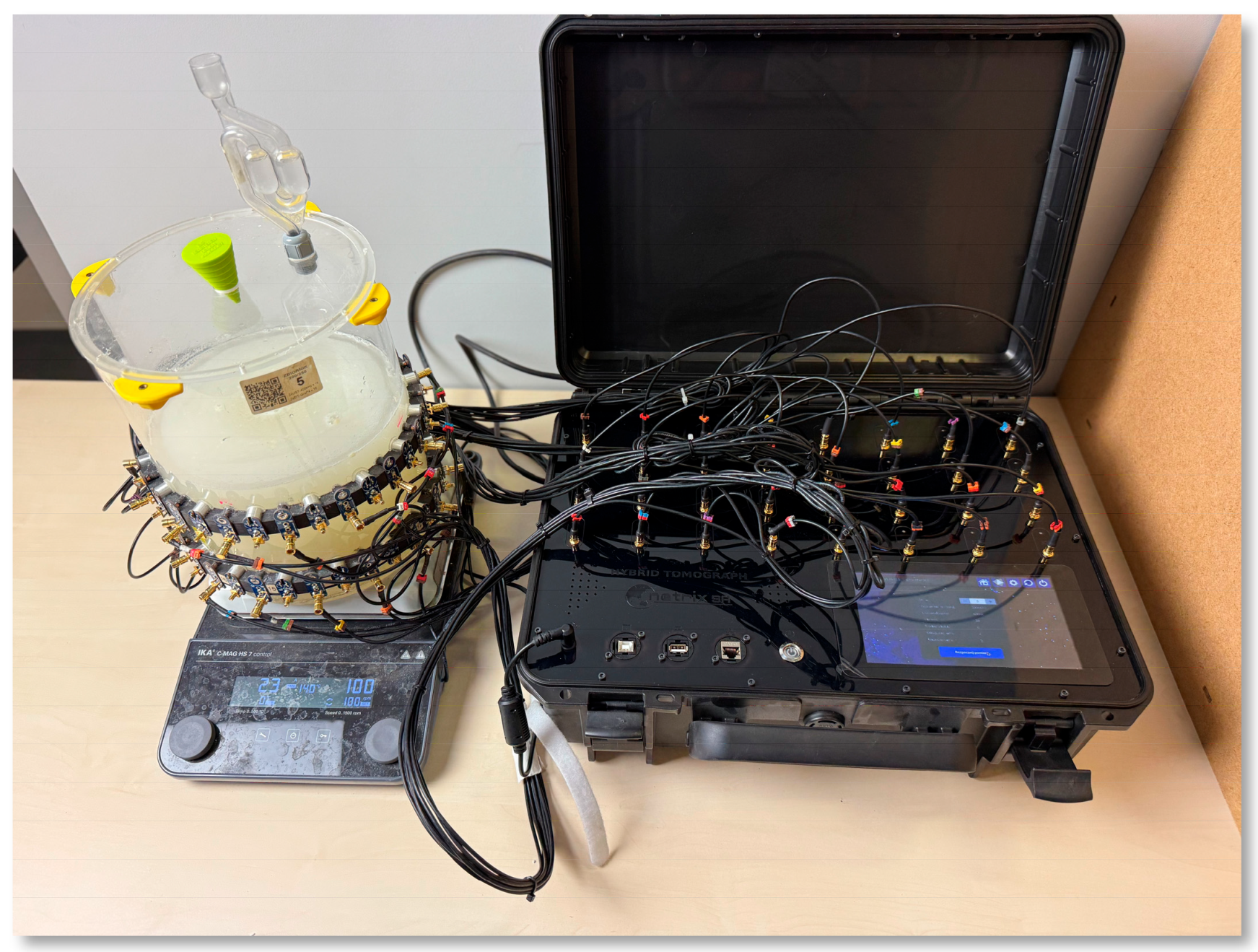



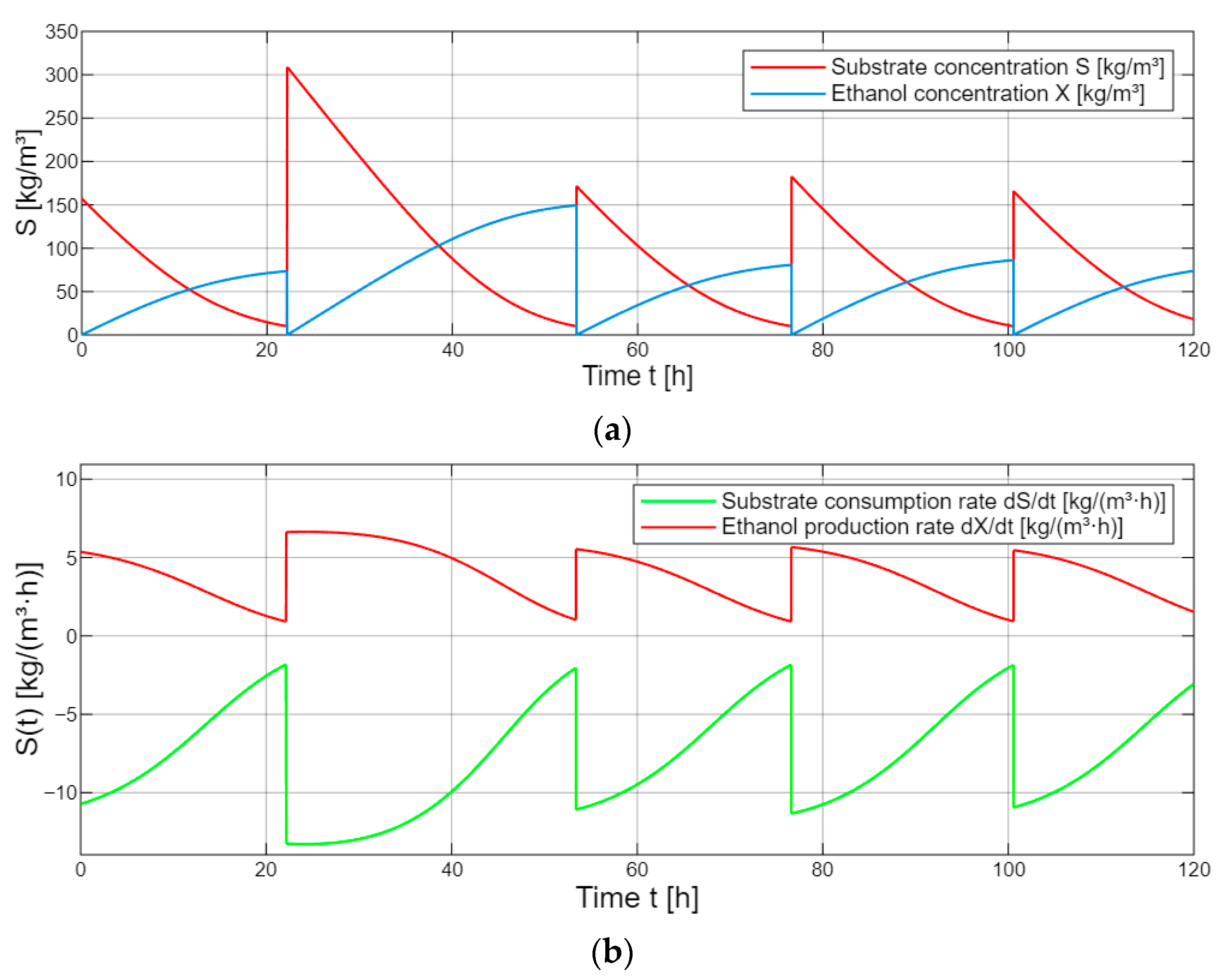

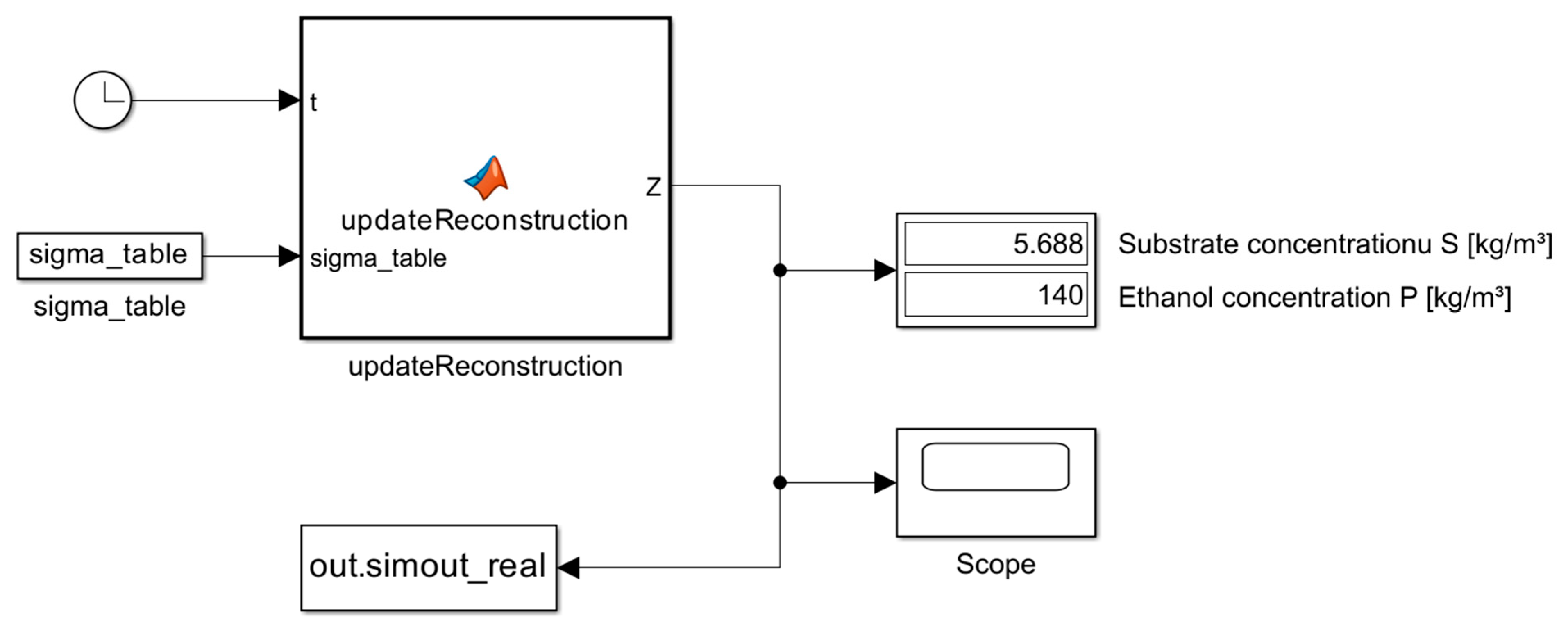

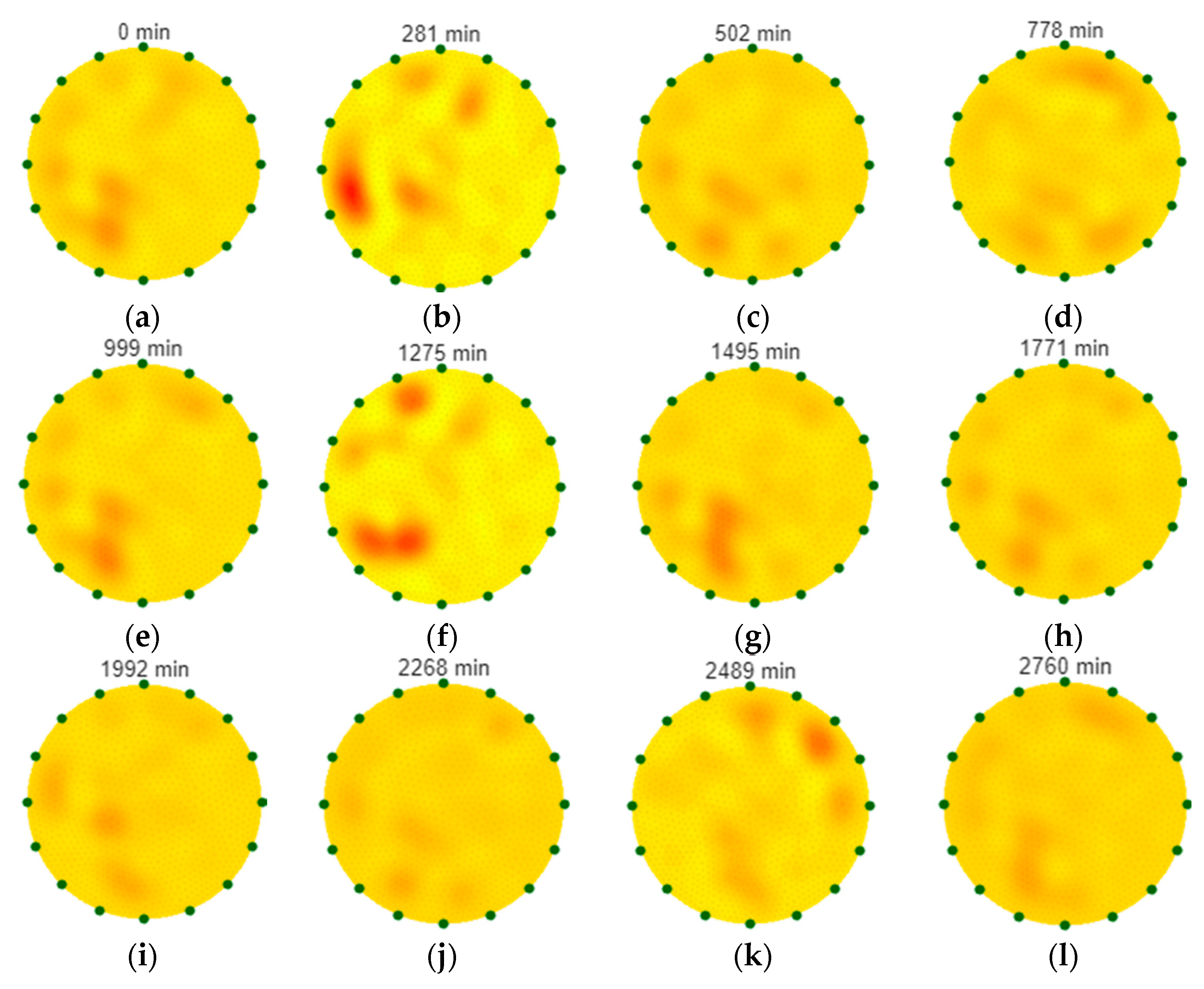
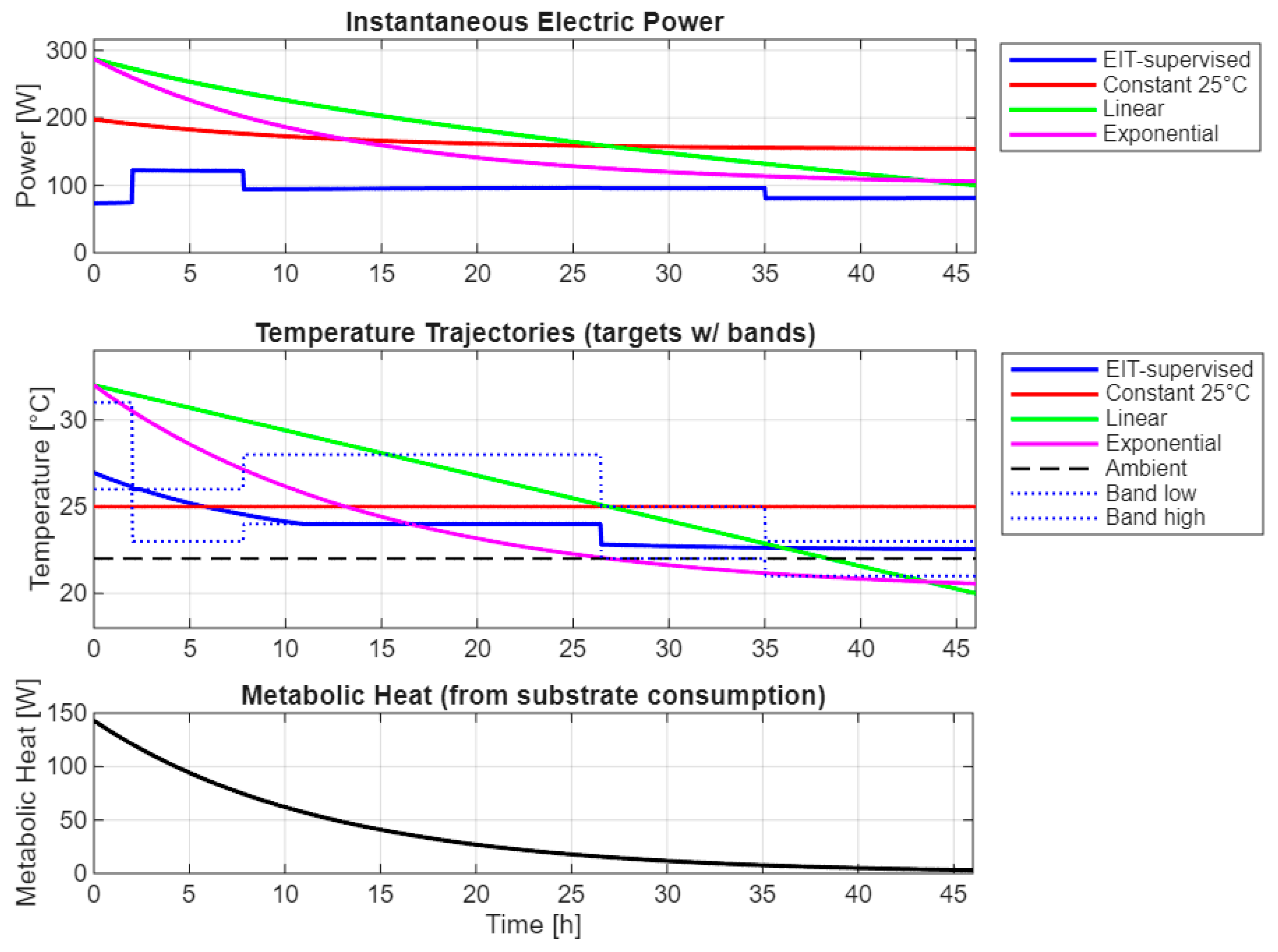


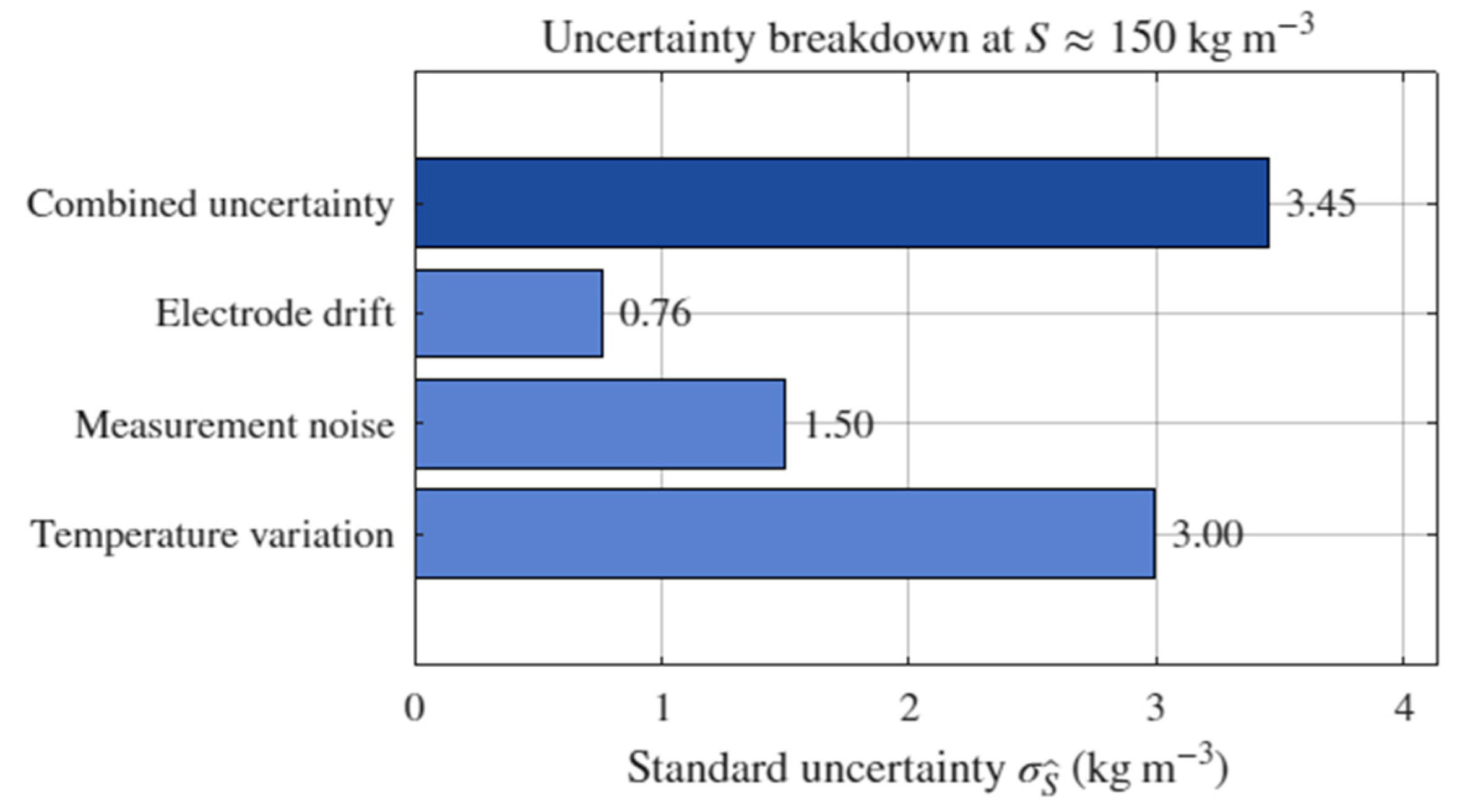
Disclaimer/Publisher’s Note: The statements, opinions and data contained in all publications are solely those of the individual author(s) and contributor(s) and not of MDPI and/or the editor(s). MDPI and/or the editor(s) disclaim responsibility for any injury to people or property resulting from any ideas, methods, instructions or products referred to in the content. |
© 2025 by the authors. Licensee MDPI, Basel, Switzerland. This article is an open access article distributed under the terms and conditions of the Creative Commons Attribution (CC BY) license (https://creativecommons.org/licenses/by/4.0/).
Share and Cite
Król, K.; Kłosowski, G.; Rymarczyk, T.; Gauda, K.; Kulisz, M.; Golec, E.; Surowiec, A. Process Control via Electrical Impedance Tomography for Energy-Aware Industrial Systems. Energies 2025, 18, 5956. https://doi.org/10.3390/en18225956
Król K, Kłosowski G, Rymarczyk T, Gauda K, Kulisz M, Golec E, Surowiec A. Process Control via Electrical Impedance Tomography for Energy-Aware Industrial Systems. Energies. 2025; 18(22):5956. https://doi.org/10.3390/en18225956
Chicago/Turabian StyleKról, Krzysztof, Grzegorz Kłosowski, Tomasz Rymarczyk, Konrad Gauda, Monika Kulisz, Ewa Golec, and Agnieszka Surowiec. 2025. "Process Control via Electrical Impedance Tomography for Energy-Aware Industrial Systems" Energies 18, no. 22: 5956. https://doi.org/10.3390/en18225956
APA StyleKról, K., Kłosowski, G., Rymarczyk, T., Gauda, K., Kulisz, M., Golec, E., & Surowiec, A. (2025). Process Control via Electrical Impedance Tomography for Energy-Aware Industrial Systems. Energies, 18(22), 5956. https://doi.org/10.3390/en18225956






